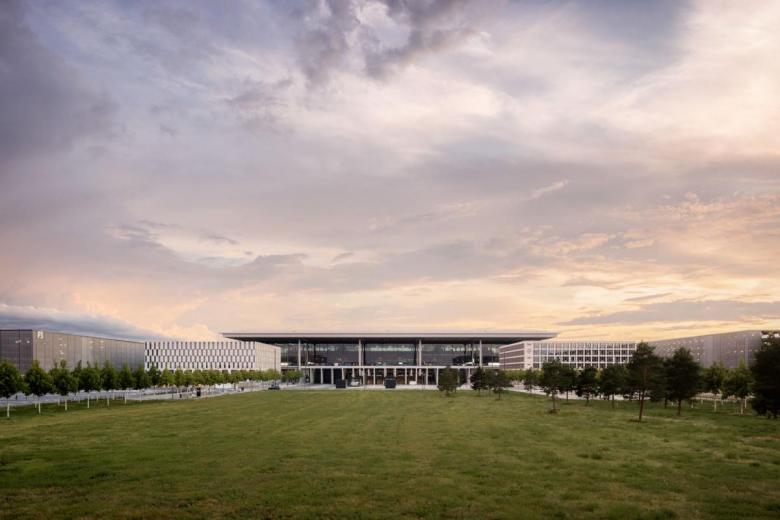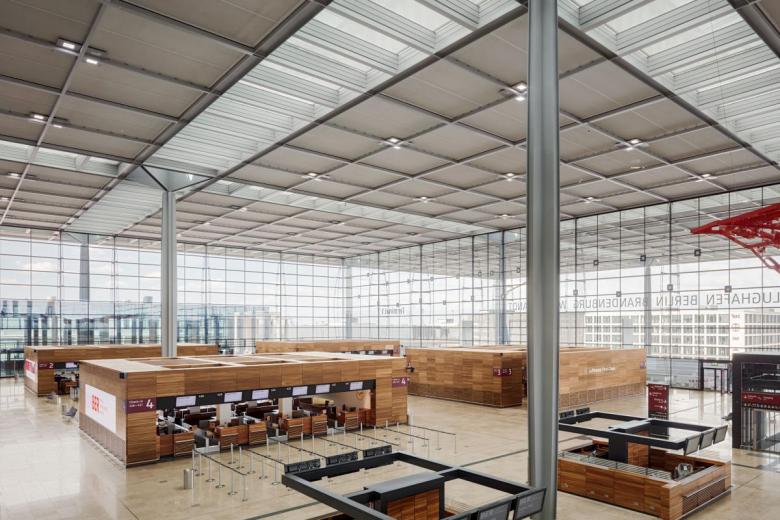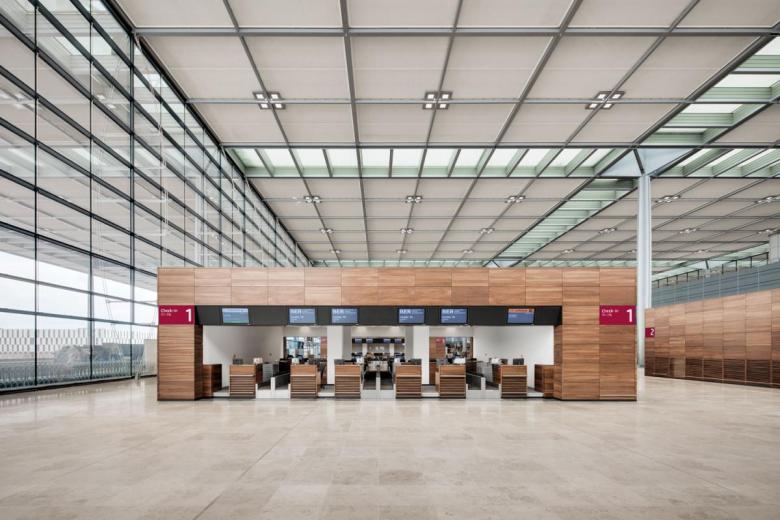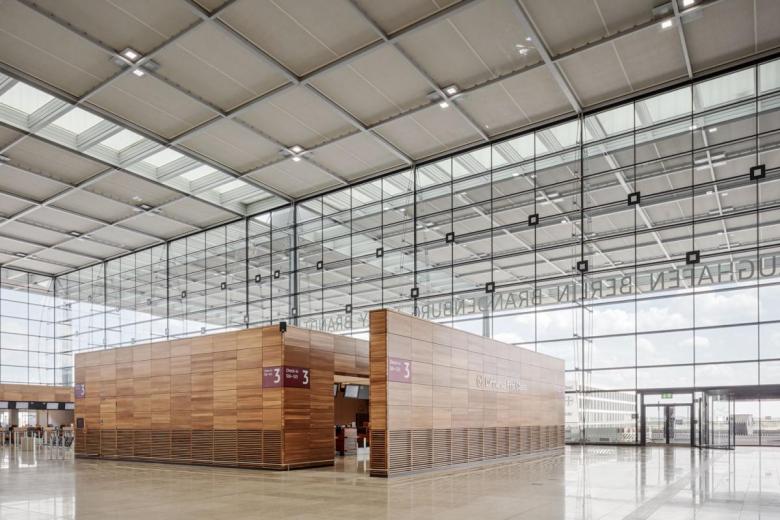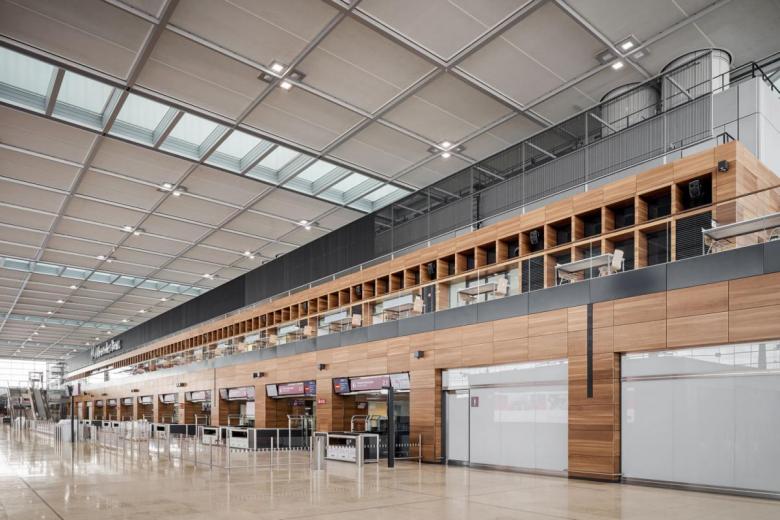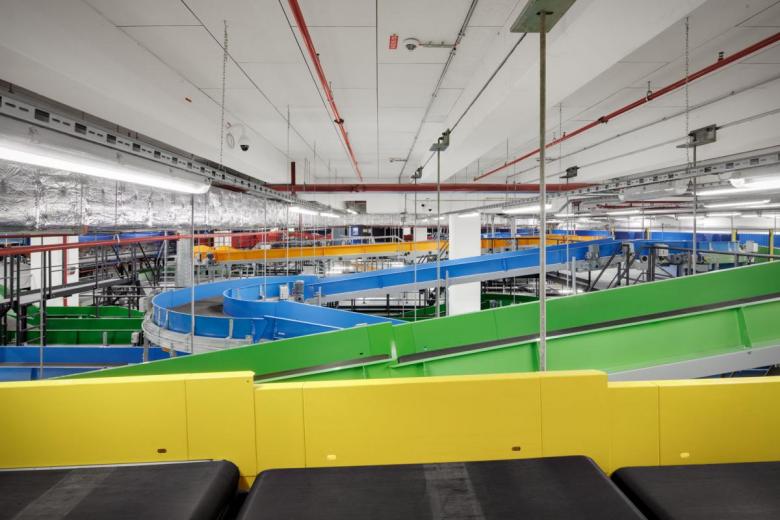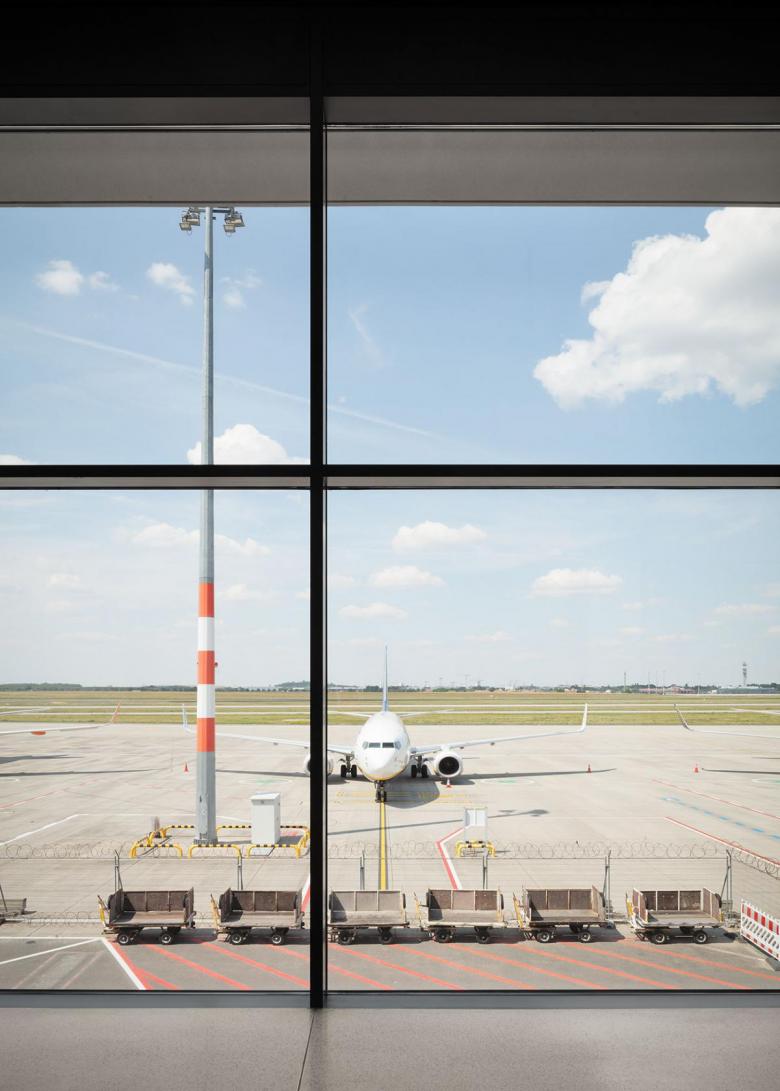Finally Ready for Take-Off
Falk Jaeger
28. September 2020
Photo: Marcus Bredt
Beyond all the scandals, the new Berlin Brandenburg Airport Willy Brandt (BER) promises to achieve what architecture is supposed to achieve. The airport is scheduled to open at the end of October.
All's well that ends well? Absolutely not. Whereas the scandal surrounding the Elbphilharmonie Concert Hall in Hamburg has subsided because the cost explosion came to an end and the result is generally convincing, Berlin's BER airport is facing further turbulence. The building is now complete and will open at the end of October — most likely, but who really knows? Although the architecture, which proves to be of a decent quality, promises to be passenger-friendly in terms of function and efficient in terms of logistics and organization, the financial risks remain and are exacerbated by the coronavirus pandemic. It was only at the beginning of September that more bad news came to light and the shareholders had to make a short-term financial injection of 300 million euros in order to avoid the insolvency of the airport company before the official opening. A further 500 million euros are needed next year. In the political arena, voices are once again becoming louder, calling for a painful break rather than drawing out the agony: withdraw public funds from the never-ending financing, insolvency, privatization, and acceptance of the Paris airport company ADP as fourth shareholder.
The design of the concourse roof is based on the pervasive grid of the complex. (Photo: Marcus Bredt)
Everyone involved is expected to finally be able to breathe a sigh of relief. The airport's CEO, Engelbert Lüdke Daldrup, who has been in office for three and a half years, has succeeded in regaining control over the structural and organizational disaster that his shiftless predecessors lost, ending the unspeakably expensive situation of working with companies without a contractual basis and obliging them to sign new binding contracts. He has put an end to the fatal practice of his predecessors of trying to solve problems by commissioning more and more external consulting firms. They came and went, leaving new questions unanswered and presenting exorbitant invoices. He also succeeded in staying out of the influence of politicians who were unfamiliar with the field but eager to shape their own image.
The check-in counters are not left to the individual airlines and their creative ideas. (Photo: Marcus Bredt)
For the time being, the scandals have faded from the spotlight, and so attention can shift to the architecture itself. Looking at the building, one critic noted, it's clear that the design was developed in 2005; the architectural vocabulary is somewhat outdated. Well, it can be assumed that one decade later, the architects at gmp would not have offered any other type of architecture than their "timeless" rationalism. "Nevertheless, it does have a very pleasant appeal," the critic concedes, only to stigmatize the "extreme functional fetishism" — something very German — "that once passengers leave the aircraft they can go immediately to the bathrooms." This also applies to the perfect connection of the suburban and mainline railway to the main building. Anyway, the criticism comes to nothing. Passengers will appreciate this kind of fetishism.
Another critique is that the building has no feel of flying at all. Quite true, BER does not begrudge the aircrafts their dynamic shape. It is rationalistic, has more of Brandenburg and Berlin, of Schinkel and Mies van der Rohe — and perhaps a little technicism from Norman Foster's Stansted Airport. It is not signature architecture or a spectacular landmark, but it is serious, well thought-out, functional architecture, which will nevertheless stick in the memory of foreign travelers. This is because, like the Tegel Airport but naturally not on the same scale, BER is an airport of short distances by international standards. And it offers a maximum of orientation: views into, out of and through the building, which provide security for passengers who are already stressed out. Passengers will always know where they are and where the route leads them; they will not, as is often the case, be solely dependent on a wayfinding system.
Shell limestone floors and walnut wood characterize the atmosphere in the circulation area for passengers. (Photo: Marcus Bredt)
On arrival at the station by train, directly below the terminal, or by taxi or bus, protected by the generous (some naggingly call it monumental) canopy, passengers are welcomed by a spacious central entrance hall with check-in counters. Directly behind are the security checkpoints, which can be accessed in a relaxed fashion over a width of 220 meters, followed by the unavoidable shops and restaurants and the concourse with the waiting areas. At both ends of the concourse are the terminals of budget airlines, which send their passengers to the aircraft at ground level. The average distance from check-in to the cabin door is only 400 meters, the longest 750 meters.
The architects have contrasted the hectic airport operations with a quiet interior. Everything appears clean and well-organized. Above all, they succeeded in keeping the screaming advertising installations at bay by designating fixed locations for billboards.
Short distances: there is no shortage of security control lines immediately behind the check-in area. (Photo: Marcus Bredt)
The airport stands solidly on the ground and offers pleasant, low-stress interiors, including an inter-religious room of silence. The interior's walnut surfaces generate a far more homely atmosphere than the usual, supposedly aircraft-suitable stainless steel, LED, and plastic — so is the philosophy behind the design. The passenger has to cope with enough plastic and flashing technology during the flight anyways.
Beyond the areas accessible to passengers, the architects at von Gerkan, Marg und Partner have incorporated new ideas that are being studied curiously by airport planners from all over the world, such as the "mono-beat sequence" of gates with a consistent distance between them, where larger aircraft simply take up two spaces. This increases capacity. The primary objective was to keep the turnaround time (the time the aircraft is at the gate) as short as possible. Each gate is therefore assigned three waiting areas. Boarding and disembarking passengers, Schengen and non-Schengen passengers, do not get in each other's way. There are only ramps at the gate and, alternatively, stairs, but no mechanical means of transport that are prone to malfunction.
In the two-hectare baggage hall, "moving fire loads" are to be controlled. (Photo: Marcus Bredt)
Baggage handling is no longer the responsibility of individual airlines. All counters are available for common use for all flights, which ensures better utilization. Downstairs in the almost two-hectare baggage hall, the "world's best" sorting system ensures smooth distribution. Eight thousand pieces of baggage alone can be temporarily stored in parking positions, so transit baggage does not have to be stored by hand in the event of delayed connecting flights and pre-checks are possible many hours before departure. "A good airport opens early" is the credo.
From the end of October onwards, both the operator and the architects expect the terminal to function smoothly with above-average speed and efficiency, also due to the slow start-up caused by the coronavirus. Soon the new BER airport can finally prove itself.
The vast view of the Brandenburg countryside from the side terminal for budget airlines. (photo: Marcus Bredt)
This article was originally published as "Endlich am Start" on German-Architects. Translation by Bianca Murphy.
